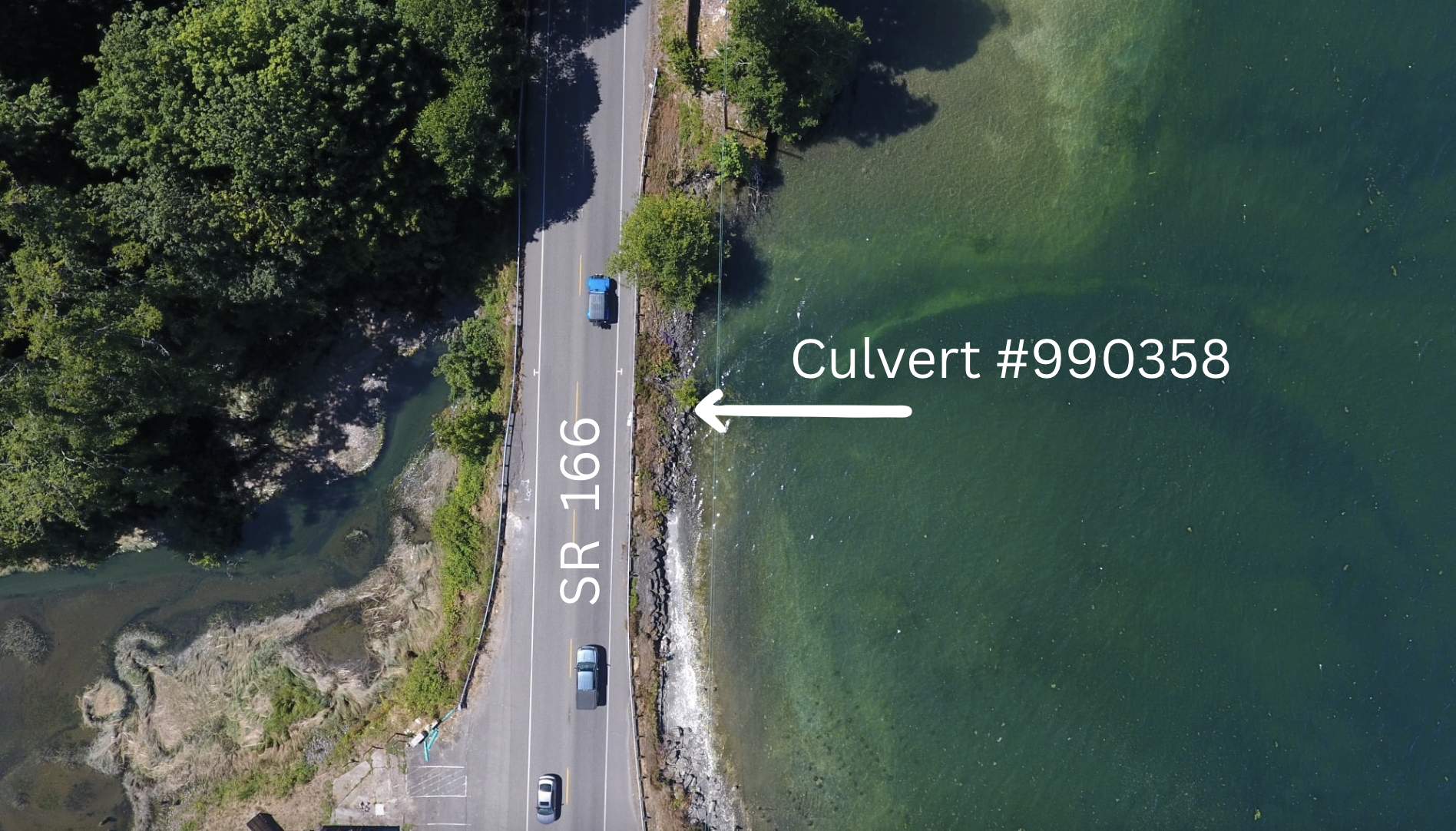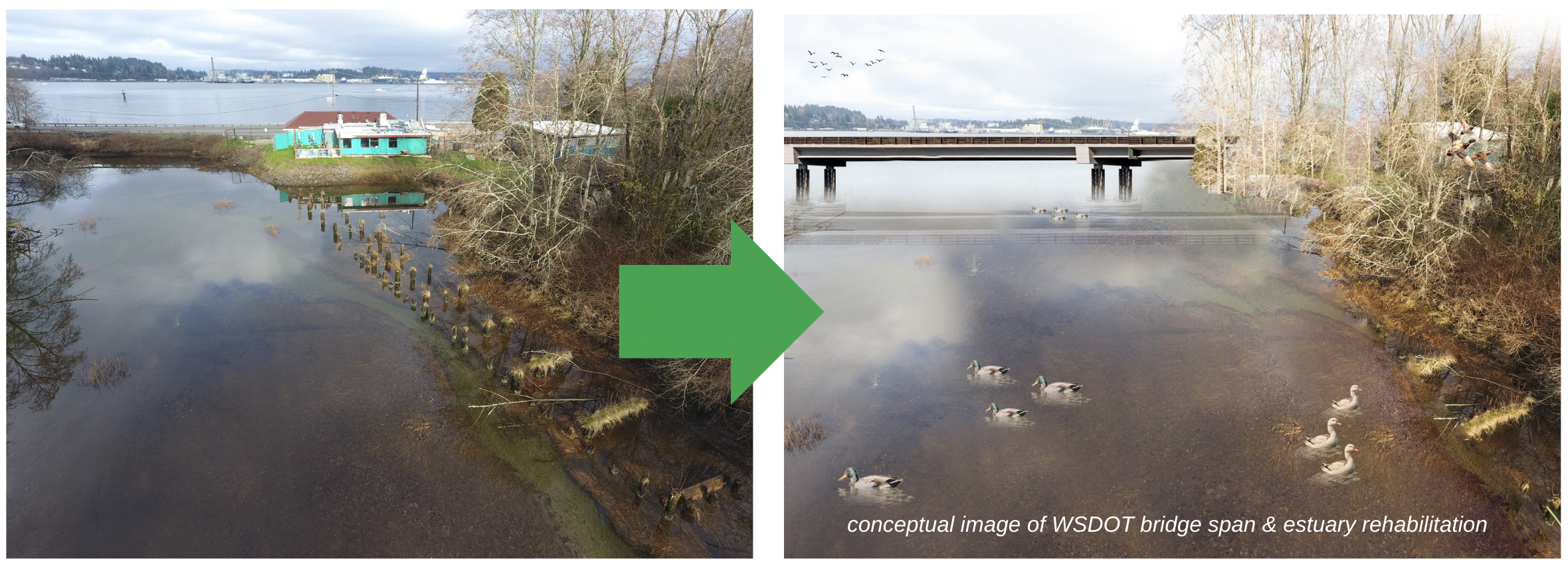Ross Creek Culvert
Replacement Project
An economic & ecological case to prioritize the WSDOT Ross Creek culvert project.
The Importance of Prioritizing the Ross Creek Estuary Culvert
Current Conditions
Culvert site #990358 drains the Ross Creek estuary under SR 166 into Sinclair Inlet. WSDOT prioritizing work at the Ross Creek estuary culvert (#990358) has numerous benefits. It is a unique opportunity to support the Sinclair Inlet ecosystem and will support an effective partnership with the estuary & creek restoration work of Waterman Mitigation Partners (WMP).
If WSDOT does not expedite and prioritize the Ross Creek estuary culvert replacement and coordinate efforts with WMP’s in-progress Ross Creek restoration work, a valuable opportunity will be lost to expand the estuary to its maximum extent. Additionally SR 166 will have to be closed and detoured, cutting off residents and visitors from accessing the Port Orchard downtown corridor directly from SR 166 for up to 12 months.
Best case scenario: WSDOT constructs a bridge span allowing for the largest possible estuary footprint in coordination with WMP’s habitat work, mitigating the need for road closures and ensuring maximum habitat lift. Considering there has been increased funding for the the statewide culvert replacement project, what better time to reevaluate the priority of the Ross Creek estuary culvert?
The Ross Creek estuary culvert is currently a 6 ft wide concrete box culvert flowing under SR 166. The intake is approximately 40% filled in with sediment and the outflow at middle - low tide has a drop of several feet.
These conditions are the result of the Ross Creek estuary being mostly blocked and partially filled, first by 19th century logging activities, and then by WSDOT construction of SR 166. The current conditions of the culvert and SR 166 has severely degraded Ross Creek’s ability to support the life cycle of native salmon species. Recent Ross Creek salmon spawning surveys have reported extremely low numbers of returning fish. The Ross Creek estuary and watershed also have more than 14 acres of potential rearing habitat. However, the degraded conditions of the culvert makes it difficult for juvenile fish to access the estuary. This is unfortunate because nearby Gorst Creek supports one of the county’s largest salmon runs, including a significant Chinook run. Every year millions of juvenile salmon from Gorst Creek enters Sinclair inlet where safe and healthy rearing habitat is sparse.
Of the approximate 6 miles of Sinclair Inlet shoreline between downtown Port Orchard and Puget Sound Naval Shipyard, very little of it is in a healthy natural condition. Restoring the Ross Creek estuary, enhancing upstream conditions, and opening the estuary up to full tidal influence would provide significantly more benefit to fish and wildlife habitat than any other proposed WSDOT actions around Sinclair Inlet.
Aligning Priorities to Support Port Orchard
WSDOT’s culvert replacement guidelines are as follows:
Habitat Gain – We prioritize barrier corrections that open the most habitat soonest to get these benefits to fish fastest.
Partnership Opportunities – We consider nearby barriers owned by cities, locals and private parties to partner on correcting multiple barriers at the same time.
Culvert Condition – We prioritize culverts that are failing structurally.
Downstream Barriers – We place a high value on correcting culverts with no or few downstream barriers in order to provide immediate benefits to fish.
Geographic Bundling & Public Impacts – In areas where there are many barriers along state highways it can be beneficial to group the correction efforts into one “bundle.” This may help reduce traffic delays, impacts to neighbors and can open more habitat together in a watershed.
Tribal Input – Working with tribes is extremely important for fish passage projects, and input from tribes on priorities is valued.
Project Readiness – Planning and prioritizing projects that are ready to deliver gives planners and designers more time to work on complicated projects.
Public Impacts – We always consider the effects to the public for our fish passage projects. Bundling projects helps avoid repeated road closures and construction impacts to adjacent neighbors.
Clearly replacing the Ross Creek estuary culvert with an expanse bridge meets most of these guidelines. In fact, if this prioritization is applied as it should be, Ross Creek should be at the top of the list for all Sinclair Inlet WSDOT projects.




